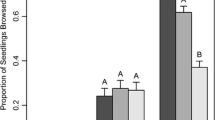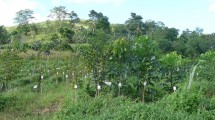Abstract
We examined separate and interactive effects of intraspecific competition, vertebrate browsing and substrate disturbance on the growth and size structure of pin cherry (Prunus pensylvanica L.) in the first two seasons of growth after clearcutting, in a hardwoods forest in New Hampshire, United States. Over the 15-month study period, 97.5% of 1801 individuals survived, and mean plant height increased from 4-fold at high density to 5-fold at low density. Relative height growth was significantly lower at higher plant densities in two of the three growth periods examined. Vertebrate browsers (moose and deer) significantly preferred taller plants. Browsed plants had higher relative height growth following browsing than unbrowsed plants (compensatory growth) at low and intermediate densities. The degree of compensation declined with density and compensation was not significant at the highest density level. At low and intermediate densities, plants browsed early in life regained height dominance through compensatory growth; they failed to regain dominance at high density. Because compensatory growth tended to offset the effects of size-selective browsing, there was no difference in the degree of size inequality between browsed and unbrowsed plots. However, size inequality increased with plant density. Substrate disturbance caused by logging had no significant effects on either relative height growth or size inequality. The slope of the relationship between relative height growth and initial height increased significantly with density and time, and was higher in unbrowsed than in browsed plots, suggesting that competition among plants was size-asymmetric. Despite the preference of browsers for large plants, there was a clear net growth advantage for plants of large initial size, when the effects of competition, browsing and compensatory growth were combined. The interactive effects of density and browsing demonstrate the importance of a multifactorial approach to the analysis of individual plant performance and population structure.
Similar content being viewed by others
References
Bendel RB, Higgins SS, Teberg JE, Pyke DA (1989) Comparison of skewness coefficient, coefficient of variation, and Gini coefficient as inequality measures within populations. Oecologia 78: 394–400
Belsky AJ (1986) Does herbivory benefit plants? A review of the evidence. Am Nat 127: 870–892
Bentley S, Whittaker JB (1979) Effects of grazing by a chrysomelid beetle Gastrophysa viridula on competition between Rumex obtusifolius and R. crispus. J Ecol 68: 671–674
Bonan GB (1988) The size structure of theoretical plant populations: spatial patterns and neighborhood effects. Ecology 69: 1721–1730
Bonan GB (1991) Density effects on the size structure of annual plant populations: An indication of neighbourhood competition. Ann Bot 68: 341–347
Bormann FH, Likens GE (1979) Pattern and process in a forested ecosystem. Springer, New York
Brun EL (1950) Deciduous forests of eastern North America. Blakiston, Philadelphia
Cottam DA, Whittaker JB, Malloch AJC (1986) The effects of chrysomelid beetle grazing and plant competition on the growth of Rumex obtusifolius. Oecologia 70: 452–456
Crawley MJ (1983) Herbivory: the dynamics of animal-plant interactions. Blackwell Scientific, Oxford
Crawley MJ, Weiner J (1991) Plant size variation and vertebrate herbivory: winter wheat grazed by rabbits. J Appl Ecol 28: 154–172
Fienberg SE (1980) The analysis of cross-classified categorical data. MIT Press, Cambridge
Fowler NL (1988) What is a safe site?: neighbor, litter, germination date, and patch effects. Ecology 69: 947–961
Fowler NL, Rausher MD (1985) Joint effects of competitors and herbivores on growth and reproduction in Aristolochia reticulata. Ecology 66: 1580–1587
Gange AC, Brown VK (1989) Insect herbivory affects size variability in plant populations. Oikos 56: 351–356
Grime JP (1977) Evidence for the existence of three primary strategies in plants and its relevance to ecological and evolutionary theory. Am Nat 111: 1169–1194
Gurevitch J, Wilson P, Stone JL, Teese P, Stoutenburgh RJ (1990) Competition among old-field perennials at different levels of substrate fertility and available space. J Ecol 78: 727–744
Hartgerink AP, Bazzaz FA (1984) Seedling-scale environmental heterogeneity influences individual fitness and population structure. Ecology 65: 198–206
Hunt R (1990) Basic growth analysis. Unwin Hyman, London
Johnson WT, Lyon HH (1976) Insects that feed on trees and shrubs. Cornell University Press, Ithaca
Jones CG, Coleman JS (1991) Plant stress and insect herbivory: toward an integrated perspective. In: Mooney MA, Winner WE, Pell EJ (eds) Responses of plants to multiple stresses. Academic Press, San Diego, pp 249–280
Kozlowski TT (1991) Effects of environmental stresses on deciduous trees. In: Mooney HA, Winner WE, Pell EJ (eds) Responses of plants to multiple stresses. Academic Press, San Diego, pp 391–411
Lee TD, Bazzaz FA (1980) Effects of defoliation and competition on growth and reproduction in the annual plant Abutilon theophrasti. J Ecol 68: 813–821
Mack RN, Harper JL (1977) Interference in dune annuals: spatial pattern and neighbourhood effects. J Ecol 65: 345–363
Marks PL (1971) The role of Prunus pensylvanica L. in the rapid revegetation of disturbed sites. Ph.D. Dissert., Yale University
Marks PL (1974) The role of pin cherry (Prunus pensylvanica L.) in the maintenance of stability in northern hardwood ecosystems. Ecol Monogr 44: 73–88
Marquis DA, Bjorkbom JC, Yelenosky G (1964) Effect of seedbed condition and light exposure on paper birch regeneration. J For 62: 876–881
Miller TE, Weiner J (1989) Local density variation may mimic effects of asymmetric competition on plant size variability. Ecology 70: 1188–1191
Mohler CL, Marks PL, Sprugel DG (1978) Stand structure and allometry of trees during self-thinning of pure stands. J Ecol 66: 599–614
Müller-Schärer H (1991) The impact of root herbivory as a function of plant density and competition: survival, growth and fecundity of Centaurea maculosa in field plots. J Appl Ecol 28: 759–776
Myster RW, McCarthy BC (1989) Effects of herbivory and competition on survival of Carya tomentosa (Juglandaceae) seedlings. Oikos 56: 145–148
Mou P (1991) Biomass and nutrient accumulation following largescale disturbance of a northern hardwood ecosystem. Ph.D. Dissert., Cornell University
Obeid M, Machin D, Harper JL (1967) Influence of density on plant to plant variations in fiber flax, Linum usitatissimum. Crop Sci 7: 471–473
Rees M, Brown VK (1992) Interactions between invertebrate herbivores and plant competition. J Ecol 80: 353–360
SAS Institute (1989) SAS/STAT user's guide, version 6, 4th ed. Sas Institute Inc., Cary NC
Schmid B, Miao SL, Bazzaz FA (1990) Effects of simulated root herbivory and fertilizer application on growth and biomass allocation in the clonal perennial Solidago canadensis. Oecologia 84: 9–15
Schmitt J, Ehrhadt DW, Cheo M (1986) Light-dependent dominance and suppression in experimental radish populations. Ecology 67: 1502–1507
Schmitt J, Eccleston J, Ehrhardt DW (1987) Dominance and suppression, size-dependent growth and self-thinning in a natural Impatients capensis population. J Ecol 75: 651–665
Steinger T, Müller-Schärer H (1992) Physiological and growth responses of Centaurea maculosa (Asteraceae) to root herbivory under varying levels of interspecific plant competition and substrate nitrogen availability. Oecologia 91: 141–149
Swank SE, Oechel WC (1991) Interactions among the effects of herbivory, competition, and resource limitation on chaparral herbs. Ecology 72: 104–115
Thomas SC, Bazzaz FA (1993) The genetic component in plant size hierarchies: norms of reaction to density in a Polygonum species. Ecol Monogr 63: 231–249
Thomas SC, Weiner J (1989) Including competitive asymmetry in measures of local interference in plant populations. Oecologia 80: 349–355
Turner MD, Rabinowitz D (1983) Factors affecting frequency distributions of plant mass: the absence of dominance and suppression in competing monocultures of Festuca paradoxa. Ecology 64: 469–475
US Department of Agriculture (1985) Insects of eastern forests. (Miscellaneous publication 1426) USDA Forest Service, Washington DC
Weiner J (1985) Size hierarchies in experimental populations of annual plants. Ecology 66: 743–752
Weiner J (1990) Asymmetric competition in plant populations. Trends Ecol Evol 5: 360–364
Weiner J, Solbrig OT (1984) The meaning and measurement of stze hierarchies in plant populations. Oecologia 61: 334–336
Weiner J, Thomas SC (1986) Size variability and competition in plant monocultures. Oikos 47: 211–222
Weiner J, Mallory EB, Kennedy C (1990) Growth and variability in crowded and uncrowded populations of dwarf marigolds (Tagetes patula). Ann Bot 65: 513–524
Whittaker JB (1979) Invertebrate grazing, competition and plant dynamics. In: Anderson RM, Turner BD, Turner LR (eds) Population Dynamics. Blackwell Scientific, Oxford, pp 202–222
Author information
Authors and Affiliations
Rights and permissions
About this article
Cite this article
Shabel, A.B., Peart, D.R. Effects of competition, herbivory and substrate disturbance on growth and size structure in pin cherry (Prunus pensylvanica L.) seedlings. Oecologia 98, 150–158 (1994). https://doi.org/10.1007/BF00341467
Received:
Accepted:
Issue Date:
DOI: https://doi.org/10.1007/BF00341467




